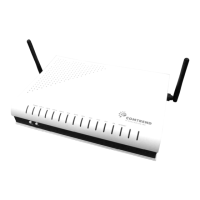
Do you have a question about the Comtrend Corporation VI-3223u and is the answer not in the manual?
| Brand | Comtrend Corporation |
|---|---|
| Model | VI-3223u |
| Category | Gateway |
| Language | English |
Basic safety guidelines for handling the electronic device.
Lists the capabilities and specifications of the VI-3223u device.
Illustrates a typical network setup and usage scenario for the device.
Provides instructions for physically connecting the device components.
Details the procedure for restoring the device to factory default settings.
Guides on how to properly power up the device.
Explains how to use the button to enable/disable the wireless LAN.
Describes the function of the WPS button for client connection.
Explains the meaning of various front panel LED lights for device status.
Lists the default IP addresses, usernames, and passwords for device access.
Details how to configure IP settings on a PC for device access.
Step-by-step guide to access the device's web interface.
Overview of the device's hardware, software, and IP settings.
Displays configured WAN connection details and status.
Provides various network traffic statistics for the device.
Shows detailed statistics specific to the xDSL connection type.
Explains how to perform a Bit Error Rate test for the DSL connection.
Describes how to view the xDSL bits per tone status graphically.
Displays the routing table showing network paths the device uses.
Shows Address Resolution Protocol (ARP) information for network devices.
Lists active DHCP leases and IP address assignments.
Displays active Network Address Translation (NAT) sessions.
Configures the physical layer connections (ATM, PTM, Ethernet).
Guides on configuring Asynchronous Transfer Mode (ATM) interfaces.
Guides on configuring Packet Transfer Mode (PTM) interfaces.
Guides on configuring Ethernet WAN interfaces.
Configures and manages WAN service connections.
Configures Local Area Network (LAN) settings, including IP and DHCP.
Configures Network Address Translation (NAT) settings.
Sets up port forwarding to direct incoming traffic to internal servers.
Dynamically opens firewall ports for specific applications.
Configures a DMZ host to receive traffic not handled by other rules.
Maps local IP addresses to specified public WAN IP addresses.
Configures network security features like IP and MAC filtering.
Sets rules to limit or allow IP traffic based on criteria.
Filters network access based on MAC addresses for wireless security.
Manages network access for specific devices based on time and content.
Restricts internet access for devices based on day and time.
Filters access to websites based on URL address and port number.
Manages network traffic priority and performance.
Enables and configures Quality of Service (QoS) settings.
Configures QoS queues to manage traffic priority.
Creates traffic class rules to classify and prioritize network traffic.
Configures network routing functions.
Configures the default gateway for network traffic routing.
Manually defines static routes for network traffic.
Configures routing rules based on specific traffic policies.
Configures the Routing Information Protocol (RIP) for routing updates.
Configures Domain Name System (DNS) settings.
Configures DNS server settings for name resolution.
Sets up dynamic DNS to map a dynamic IP to a static hostname.
Allows selection of DSL modulation modes for optimal performance.
Enables Universal Plug and Play for automatic network device discovery.
Configures DNS proxy to forward DNS queries to the internet.
Enables printer sharing via the USB host port.
Allows sharing of digital media content over the network.
Manages USB storage devices connected to the modem.
Displays information about attached USB storage devices.
Groups multiple ports for WAN and LAN interfaces.
Configures IPSec tunnel mode connections for secure networking.
Manages digital certificates for secure communication.
Manages local certificates for secure communication.
Manages trusted Certificate Authority (CA) certificates.
Configures IGMP protocol settings for multicast traffic.
Configures fundamental wireless LAN settings like SSID and channel.
Configures wireless security features like WPA and WEP.
Guides on setting up wireless security using Wi-Fi Protected Setup.
Filters network access based on MAC addresses for wireless security.
Configures the device as a wireless bridge or access point.
Configures advanced wireless settings like channel, rate, and power.
Displays status of authenticated wireless stations connected to the network.
Configures basic Session Initiation Protocol (SIP) settings for voice.
Sets common parameters for SIP service.
Configures SIP settings based on service provider requirements.
Configures advanced Session Initiation Protocol (SIP) settings.
Configures advanced SIP settings based on service provider details.
Configures SIP settings for debugging purposes.
Explains how to make and manage calls using the device's voice features.
Manages and analyzes network faults for service providers.
Manages device settings including backup, update, and restore.
Saves the current device configuration to a file.
Restores device configuration from a previously saved file.
Resets the device to its factory default settings.
Manages and views system logs for monitoring and debugging.
Configures the SNMP agent for network monitoring.
Configures the TR-069 client for auto-configuration and diagnostics.
Synchronizes the router's time with Internet timeservers.
Manages access control for device users and services.
Configures user account passwords for device access control.
Controls access to services like FTP, HTTP, SNMP, TELNET.
Manages access to services based on IP addresses.
Allows firmware upgrades from a locally stored file.
Saves configuration and reboots the router.
Configures Layer 2 interfaces like ATM, PTM, and Ethernet.
Guides on configuring ATM interfaces for DSL connections.
Guides on configuring PTM interfaces for DSL connections.
Guides on configuring Ethernet WAN interfaces.
Sets up WAN services over configured Layer 2 interfaces.
Configures PPP over Ethernet (PPPoE) WAN connection.
Configures IP over Ethernet (IPoE) WAN connection.
Configures Bridging WAN connection type.
Configures PPP over ATM (PPPoA) WAN connection.
Configures IP over ATM (IPoA) WAN connection.